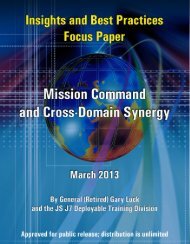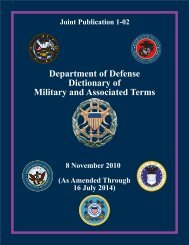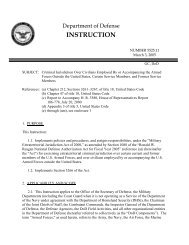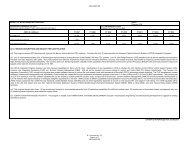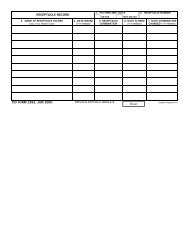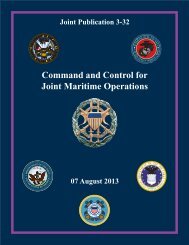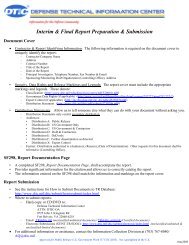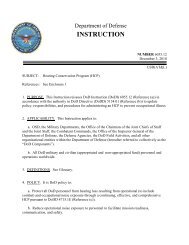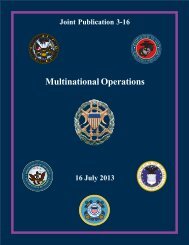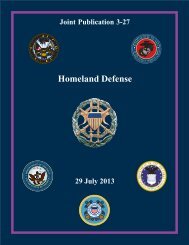JP 1, Doctrine for the Armed Forces of the United States - Defense ...
JP 1, Doctrine for the Armed Forces of the United States - Defense ...
JP 1, Doctrine for the Armed Forces of the United States - Defense ...
Create successful ePaper yourself
Turn your PDF publications into a flip-book with our unique Google optimized e-Paper software.
Chapter II<br />
Notional Composition <strong>of</strong> a Civil-Military Operations Center<br />
UNICEF<br />
World Food<br />
Programme<br />
Department <strong>of</strong><br />
Peacekeeping<br />
Operations<br />
High<br />
Commissioner<br />
<strong>for</strong> Refugees<br />
O<strong>the</strong>r UN<br />
agencies<br />
UN<br />
USG<br />
Agencies<br />
Military<br />
CMOC<br />
Red<br />
Cross<br />
NGOs<br />
CARE<br />
Doctors <strong>of</strong> <strong>the</strong><br />
World<br />
Save <strong>the</strong><br />
Children<br />
International<br />
Rescue<br />
Committee<br />
O<strong>the</strong>r relief<br />
and benefit<br />
organizations<br />
Legend<br />
CARE Cooperative <strong>for</strong> American Relief Everywhere<br />
CMOC civil-military operations center<br />
DART disaster assistance response team<br />
NGO nongovernmental organization<br />
OFDA Office <strong>of</strong> Foreign Disaster Assistance<br />
11. Multinational Operations<br />
a. General<br />
OFDA/DART<br />
USAID<br />
Country team<br />
American Red Cross<br />
International Committee <strong>of</strong> <strong>the</strong> Red Cross<br />
O<strong>the</strong>r Red Cross bodies<br />
UN<br />
UNICEF<br />
USAID<br />
<strong>United</strong> Nations<br />
<strong>United</strong> Nations Children’s Fund<br />
<strong>United</strong> <strong>States</strong> Agency <strong>for</strong> International<br />
Development<br />
<strong>United</strong> <strong>States</strong> Government<br />
Figure II-5. Notional Composition <strong>of</strong> a Civil-Military Operations Center<br />
(1) International partnerships continue to underpin unified ef<strong>for</strong>ts to address 21st<br />
century challenges. Shared principles, a common view <strong>of</strong> threats, and commitment to<br />
cooperation provide far greater security than <strong>the</strong> US could achieve independently. These<br />
partnerships must be nurtured and developed to ensure <strong>the</strong>ir relevance even as new<br />
challenges emerge. The ability <strong>of</strong> <strong>the</strong> US and its allies to work toge<strong>the</strong>r to influence <strong>the</strong><br />
global environment is fundamental to defeating 21st century threats. Wherever possible, <strong>the</strong><br />
US works with or through o<strong>the</strong>r nations, enabling allied and partner capabilities to build <strong>the</strong>ir<br />
capacity and develop mechanisms to share <strong>the</strong> risks and responsibility <strong>of</strong> today’s complex<br />
challenges.<br />
(2) Operations conducted by <strong>for</strong>ces <strong>of</strong> two or more nations are termed<br />
“multinational operations.” Such operations are usually undertaken within <strong>the</strong> structure <strong>of</strong> a<br />
coalition or alliance. O<strong>the</strong>r possible arrangements include supervision by an IGO such as <strong>the</strong><br />
UN or <strong>the</strong> Organization <strong>for</strong> Security and Co-Operation in Europe. O<strong>the</strong>r commonly used<br />
terms <strong>for</strong> multinational operations include allied, bilateral, or multilateral, as appropriate.<br />
USG<br />
II-20 <strong>JP</strong> 1



